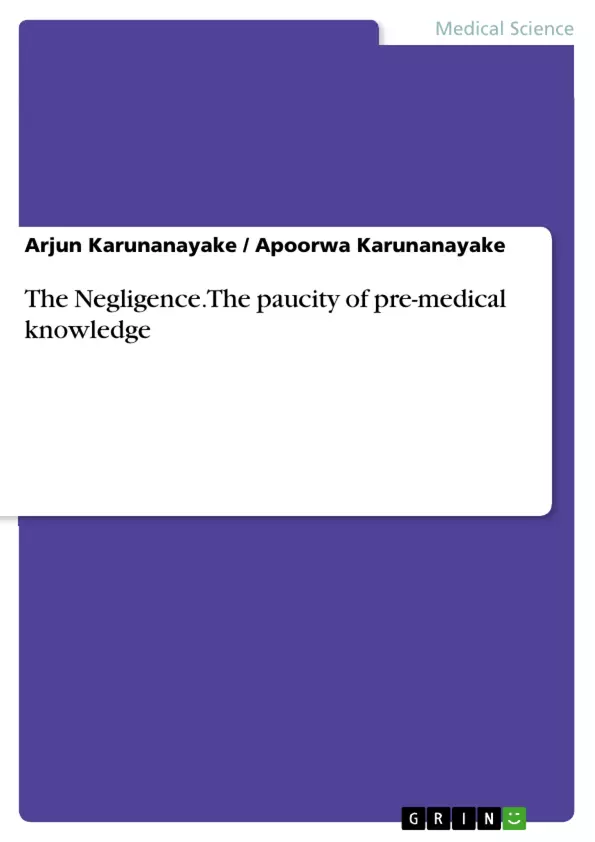The negligence of pre-medical knowledge is one hidden aspect of the society. Also known as a pre-medical care or emergency health care, first aid is the immediate attention given to a sick or injured individual until proper medical treatment arrives. This special treatment can be provided by any skilled bystander, commonly known as a first aider, prior to consultations with health professional.
It is assumed that the community as a whole neglects acquiring such vital knowledge. This book presents an overview of actual thoughts, feelings and attitudes of the society towards this knowledge. Here we present the information discovered from the public, regarding how far "the negligence" affected their daily lives. An individual at any stage of his or her life might have faced situations where the needs of primary care to a victim or the need of such assistant to oneself has occurred in their daily lives. Some may have no knowledge, while some may have limited skills to face such situations. Every individual must rely on their own life-saving skills until the arrival of medical assistance to the scene. It is assumed that many individuals do not possess adequate knowledge of standard pre-medical care in terms of "first aid".
We attended many events where people overlooked the need for pre-medical knowledge. Many life-threatening situations that could have been easily treated were neglected due to the lack of knowledge on pre-medical care. Though there are voluminous publications and courses on pre-medical care, we thought to disclose our knowledge of pre-medical care to the public. We compared several root causes and alternatives by practical observations.
This book is intended to drag the attention of the public towards the negligence of pre-medical care. It is highly recommended that this booklet is not to be considered as a complete guide or textbook on first aid treatments.
For the full medical treatments and management of such situations, it is recommended to refer standard first aid textbooks. This book merely considers the concept of negligence alone. The information for the treatment of the discussed incidents should not be applied without formal first aid training from a recognized organization or a certified trainer. Readers are strongly advised to use the contents of the book as supportive information for research needs only and not for treatment.
Inhaltsverzeichnis (Table of Contents)
- Introduction
- Overview
- First Aid or Pre-Medical Care
- The Three Ps of First Aid
- The Focus
- Significance
- Summary
- Methodology
- Introduction
- Investigated Grounds
- Assessment Tools
- Observed Sample and Response
- Evidence
- Summary
- The Depth of Negligence
- Introduction
- Basic Knowledge of the Human Body System
- Paucity of Knowledge - Negligence over Human Body System
- Knowledge of Pre-Medical Care
- Possession of Basic Formal Pre-Medical Knowledge
- Summary
- Knowledge of Pre-Medical Care
- Introduction
- Primary Survey
- Secondary Survey
- Cardiopulmonary Resuscitation (CPR)
- Recovery Position
- Dressing and Bandages
- Summary
Zielsetzung und Themenschwerpunkte (Objectives and Key Themes)
This book aims to raise awareness about the lack of pre-medical knowledge in society, highlighting its potential consequences and the importance of first aid training. The book analyzes the current state of knowledge and attitudes towards pre-medical care, explores factors contributing to its neglect, and emphasizes the crucial role of basic first aid skills in everyday situations.
- The prevalence and consequences of neglecting pre-medical knowledge.
- Factors contributing to the lack of awareness and training in first aid.
- The significance of basic pre-medical skills in emergency situations.
- The need for increased public awareness and education on first aid.
- The impact of pre-medical knowledge on individual and societal well-being.
Zusammenfassung der Kapitel (Chapter Summaries)
- Chapter 1: Introduction – This chapter defines pre-medical care (first aid), outlines its importance, and explains the book's focus on the paucity of pre-medical knowledge.
- Chapter 2: Methodology – This chapter details the research methodology employed in the book, including the investigated grounds, assessment tools, observed sample, and evidence collected.
- Chapter 3: The Depth of Negligence – This chapter explores the depth of negligence concerning pre-medical knowledge within society, analyzing public awareness of the human body system, the possession of basic first aid knowledge, and the factors hindering its acquisition.
- Chapter 4: Knowledge of Pre-Medical Care – This chapter delves into the essential components of pre-medical care, including the primary and secondary surveys, Cardiopulmonary Resuscitation (CPR), the recovery position, and dressing and bandaging techniques.
Schlüsselwörter (Keywords)
The key terms and concepts explored in this book include pre-medical care, first aid, negligence, public awareness, education, training, human body system, emergency situations, primary survey, secondary survey, CPR, recovery position, dressing, bandages, and societal well-being.
- Quote paper
- Arjun Karunanayake (Author), Apoorwa Karunanayake (Author), 2018, The Negligence. The paucity of pre-medical knowledge, Munich, GRIN Verlag, https://www.grin.com/document/387496



